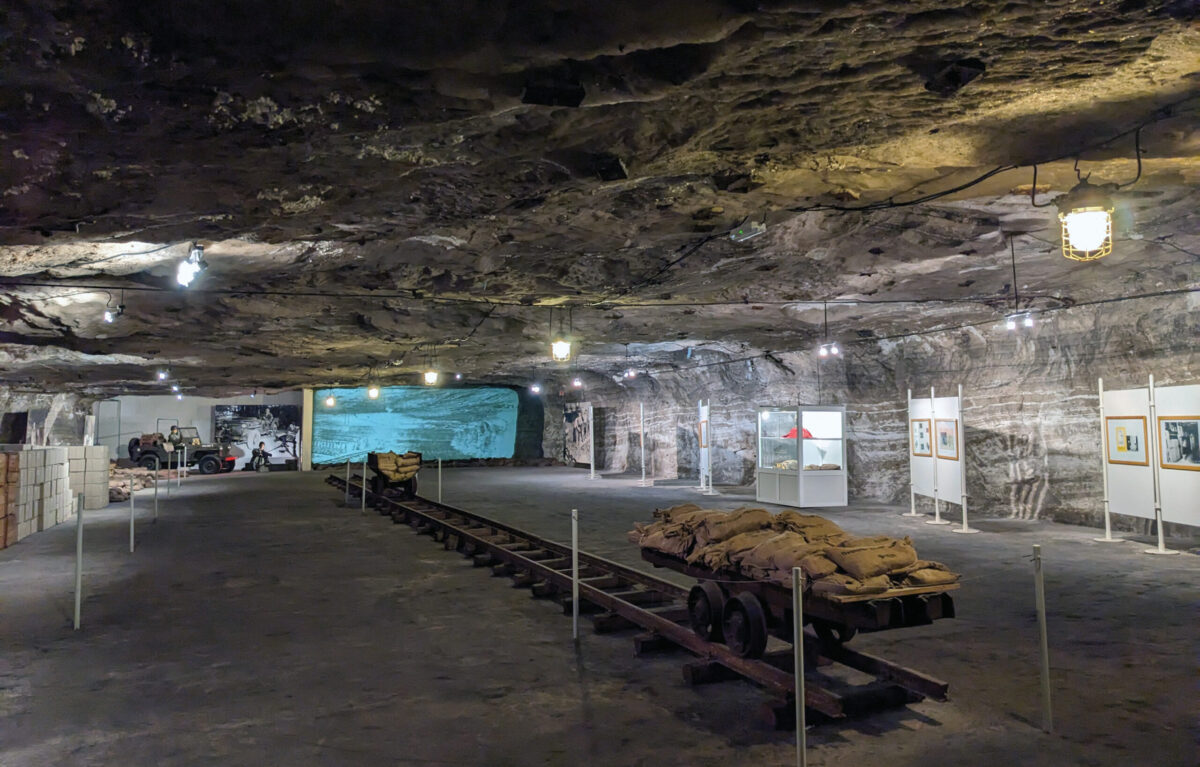With its gently rolling forests, World Heritage Sites like the monumental Wartburg Castle, and cultural icons that include Bach, Goethe, and Luther, Thuringia holds a special place in German hearts. People rave about the ethereal gorges along its popular Rennsteig hiking trail, so I decided to combine the state’s natural wonders with a personal investigation into a remarkable chapter of World War II.
Recreation was not at the forefront of Nazi minds in early 1945 when the Allies marched into Germany during the final stages of the war. As the bombing of Berlin intensified, officials from the Reichsbank, the Third Reich’s central bank, scrambled to hide the untold riches they had stolen from countries Germany had conquered. Nearly 80 years later, I am going to the Nazis’ secret gold vault at the Merkers salt mine to get a sense of those last frenetic months of hide-and-seek and the startling discovery that awaited the Americans.
Decommissioned from mining operations since 1993, the Merkers “adventure mine” boasts an underground concert hall with laser light shows, a simulated controlled blast of a salt-rock face, a dazzling crystal cave—and the original Nazi gold vault from 1945. A standard group tour of the mine, including an exhilarating ride between attractions on open flat-bed trucks, lasts three hours. My guide, Sven Grauel, takes me on a private tour of the Gold Room, the sole World War II exhibit in the complex. In keeping with regulations, I don a hard hat and join him in the staff elevator, my ears popping as we descend through the shaft at a brisk 26 feet per second.

The elevator doors open at a depth of 1,600 feet. I’m surprised how warm it is down here—around 82°F, thanks to fresh air being pumped from the surface—and by how tiny I feel in these cavernous surroundings. The facility contains roughly 2,900 miles of tunnels, embracing an area bigger than the German city of Leipzig (population 625,000). No wonder the Nazis were confident that the Americans would never find the gold’s exact location, even if they were lucky enough to stumble onto the mine. Herr Grauel and I climb into a jeep and zip through the dark, lonely underground tunnels. Before I know it, we pull up outside the Gold Room, at the exact spot where the Americans blew open the Nazis’ treasure chamber in April 1945.
Throughout much of the war, Germany held the bulk of its gold reserves at the Reichsbank in Berlin. During late 1944 and early 1945, as the Allies closed in from the east and west, the Nazis deposited more and more gold at Reichsbank branches in central and southern Germany. This policy went into overdrive after February 3, 1945, when the U.S. Eighth Air Force dropped nearly 2,300 tons of bombs on Berlin, severely damaging the Reichsbank and its currency presses. Bank president Walther Funk decided to relocate Berlin’s gold and monetary reserves for safekeeping. To shield armaments production from the bombings, Germany had already requisitioned space in its many salt and potassium mines, including a salt mine at Merkers, a village about 200 miles southwest of Berlin. It provided a perfect stronghold for the Reichsbank, with its controlled temperature, low humidity, and thick mantle of protective rock.
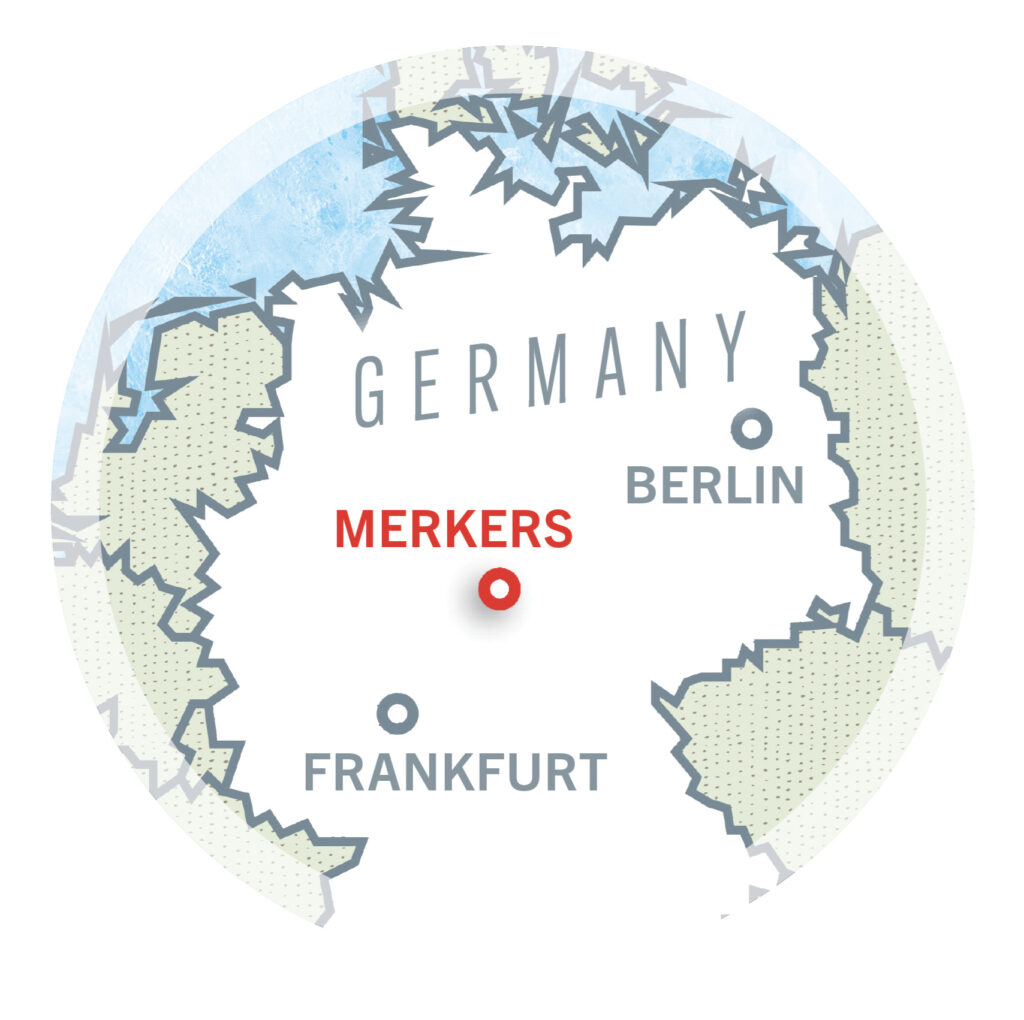
On February 11, the Reichsbank spirited the first load of the Reich’s currency reserves, a billion Reichsmarks stuffed into 1,000-mark bags and a huge number of foreign banknotes, to Merkers and deposited it in the vault, then known as Room 8. The Schutzstaffel (SS) was quick to follow and sent dozens of deliveries of ill-gotten property seized from concentration camp victims. Next came Germany’s considerable stores of art, including thousands of pilfered works of all eras and genres. Between March 20 and March 31, the Germans transported one-quarter of their major collections of 14 museums to Merkers.
In the meantime, U.S. forces were closing in on the mine. On March 22, Lieutenant General George S. Patton’s Third Army crossed the Rhine and barreled into the heart of Germany. Moving northeast from Frankfurt, Patton’s troops forged into the future Soviet zone of administration, which included Thuringia.
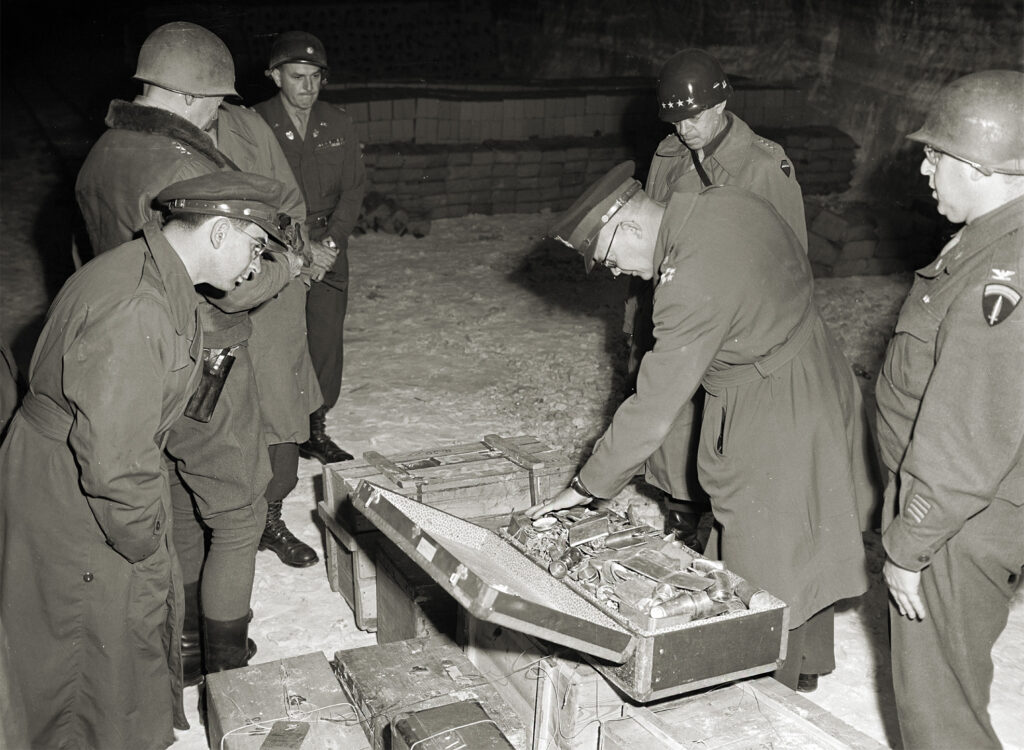
Concerned Reichsbank officials had not expected the American advance to be so swift, so they pivoted and decided to return all the Merkers treasures to Berlin. But the officials had also failed to realize that German rail service would be curtailed due to the Easter holidays (for me, an amusing footnote. Such an important mission, and the trains weren’t running?). By April 1, bank officials were resigned to leaving the gold and artwork in Merkers and focused on shifting the Reichsmarks, which were in short supply at the end of the war.
On April 2, the Germans enlisted some 20 Polish slave laborers to move the currency out of the mine. They took a considerable sum to the train station at Bad Salzungen, 6 miles from Merkers, and loaded it into a railway car. The next day, upon news of the Americans’ impending arrival, loading was stopped and the currency returned to Merkers. Early the next morning, the Germans and Polish POWs started taking the currency back down into the mine. The Reichsbank official who held the key to Room 8 had already made his escape,so the laborers left the currency at the bottom of the shaft near the elevator door.
Later that day, Merkers fell to the Third Army. On April 6, U.S. military police on a foot patrol questioned two women, displaced French citizens brought in by the Nazis for forced labor, who told how truckloads of precious metals had disappeared into the mine. The MPs relayed this information to their high command. Shortly thereafter, Werner Veick—the Reichsbank cashier in charge of foreign notes—confirmed to U.S. officers that the Reich’s entire gold reserves were behind the door of an underground vault.
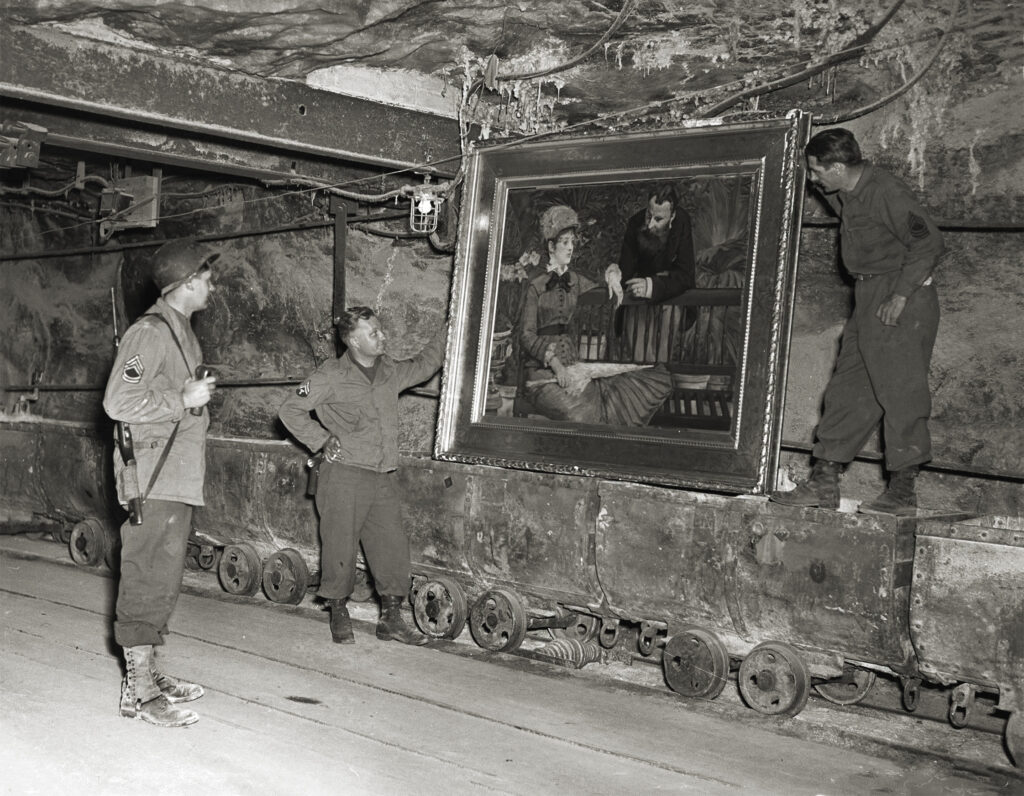
On April 10, with the key to the vault still missing, the Americans, fearing the entrance might be booby-trapped, blasted a hole in the brick masonry next to the door of Room 8. Later that day, Generals Patton, Dwight Eisenhower, and Omar Bradley arrived and were stunned by what they found. In a space measuring 75 by 150 feet, there lay no less than 7,000 bags of gold bars and coins—sealed, numbered, and neatly arranged in knee-high rows reaching to the rear wall. The contents weighed 250 tons.
In the exhibit at the Gold Room, I stop to inspect hand-operated mining carts laden with props of precious cargo on the rail track, conjuring up images of the desperate unloading of treasures as the clock ticked. A detailed 1945 sketch of the “Ploor Plan” [sic] is on display in the vault, alongside stacks of mocked-up gold bars, burlap bags marked “Deutsche Reichsbank,” cartons of fake Reichsmark notes (souvenirs for visitors), a real wartime jeep, and larger-than-life photos of U.S. military personnel guarding and cataloging the loot.
Eisenhower could hardly believe his eyes. “Crammed into suitcases and trunks and other containers was a great amount of gold and silver plate and ornament obviously looted from private dwellings throughout Europe,” the Allies’ Supreme Commander in Europe wrote in his 1948 memoir, Crusade in Europe. “All the articles had been flattened by hammer blows, obviously to save storage space, and then merely thrown into the receptacle, apparently pending an opportunity to melt them down into gold or silver bars.” A German official said the cash reserves were badly needed to pay German soldiers. “I doubt the German army will be meeting payrolls much longer,” quipped General Bradley, as he related in his 1951 account of the war, A Soldier’s Story.
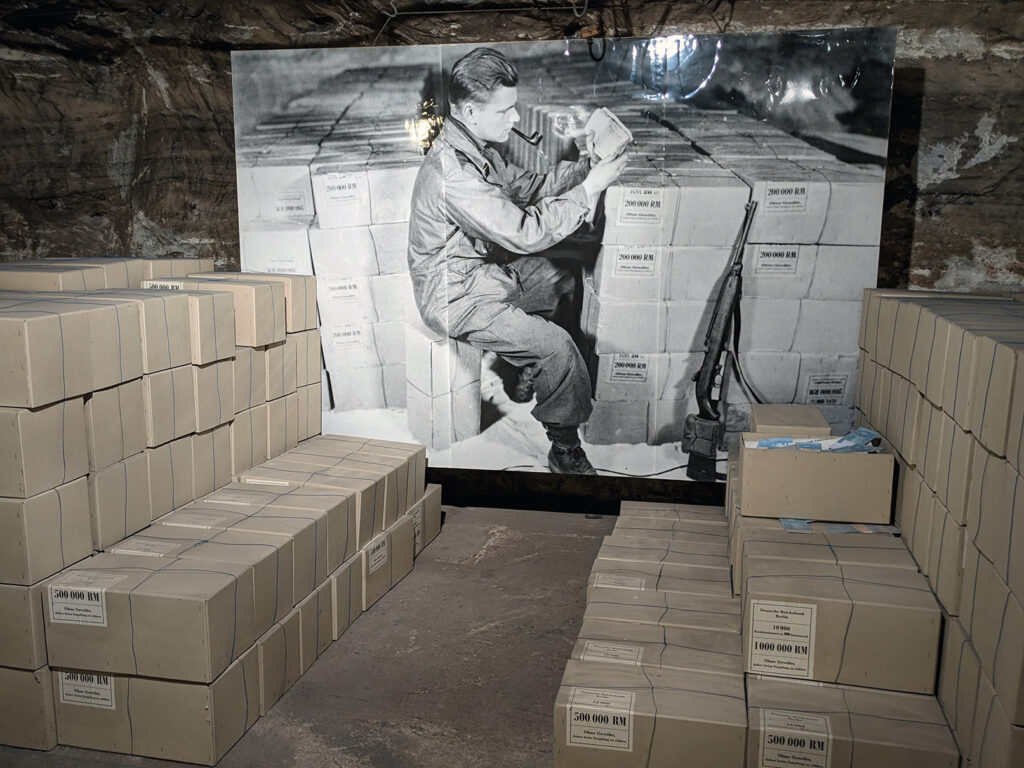
In addition, the Americans recovered some 400 tons of precious artworks from 30-odd miles of makeshift galleries in the mine. The finds included the bust of ancient Egyptian queen Nefertiti (a small copy can be seen in the Gold Room) and thousands of classic paintings such as Édouard Manet’s 1879 “In the Winter Garden.” The latter was displayed by the U.S. military for a press photo, reminiscent of the 2014 Hollywood movie TheMonuments Men.
On April 15, U.S. forces began trans-porting the gold and currency to a Reichsbank building under American control in Frankfurt. It took a convoy of 30 heavily guarded 10-ton U.S. Army trucks to handle the load, and a similar procedure followed for the artworks. There may have been a further twist en route to Frankfurt: unconfirmed reports surfaced that one or two truckloads of gold remained unaccounted for, fueling stories of “lost Nazi gold” ever since.
As the elevator whisks me back to the surface, I find myself speculating an alternative outcome: if these treasures had gone undiscovered by the Allies and continued to stoke the Nazi war machine, could the conflict in Europe have lasted even longer?

